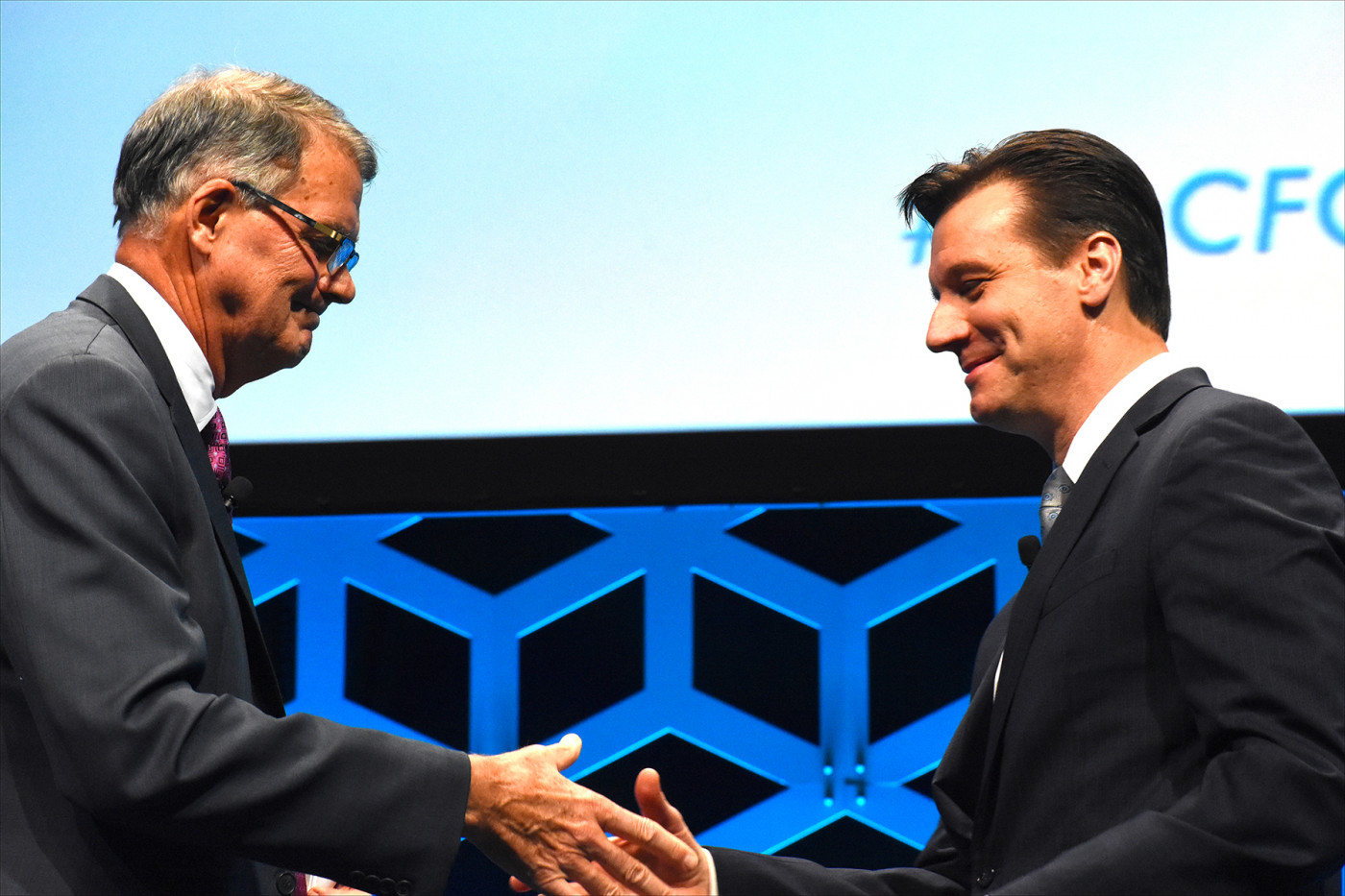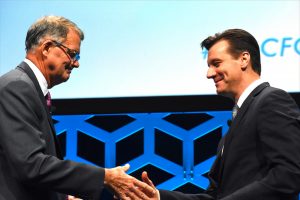New CEO Michael Boyle Outlines ‘Cure, Care, Community’ Priorities for CFF
Written by |

Preston Campbell, MD, longtime CEO of the Cystic Fibrosis Foundation (left), greets his replacement, Michael Boyle, MD, during NACFC 2019 in Nashville. (Photos by Larry Luxner)
Michael Boyle, MD, has laid out a five-year strategic plan for the Cystic Fibrosis Foundation (CFF), following his Jan. 1 appointment as president and CEO of the Maryland-based charity.
In a three-minute video message posted Jan. 9 to the CFF website, Boyle said the 2020-24 plan will focus on cure, care, and community.
“After nearly 20 years of caring for adults with CF as the director of the Johns Hopkins Adult CF Program, and another five years of leading the CFF’s clinical research and therapeutic development teams, I’ve come to know the determination and the heart of our CF community,” he said. “I am excited to step into this new role.”
As the new CFF head, Boyle — a graduate of the University of Maryland and Baltimore’s Johns Hopkins University School of Medicine — replaced Preston W. Campbell, MD, who retired at the end of 2019 after a 30-year career working with CF patients.
Boyle spoke to Cystic Fibrosis News Today on the sidelines of the 33rd North American Cystic Fibrosis Conference (NACFC), held in the fall in Nashville, Tenn. In the interview, he said he was “ecstatic” about the approval of Vertex Pharmaceuticals’ Trikafta by the U.S. Food and Drug Administration (FDA) the week before. Trikafta is a next-generation combination of three CF medications: elexacaftor, tezacaftor, and ivacaftor.
“We couldn’t be more excited about the three-drug combination,” he said of Trikafta, which treats CF patients with at least one F508del mutation in the CFTR gene, the most common CF-causing genetic defect. “First of all, in terms of how effective it is, the data speaks for itself. We’re talking about 10-14% improvement in FEV1 [forced expiratory volume in one second; a measure of lung function] in two weeks and a dramatic reduction in the frequency of exacerbations, as well as a dramatic improvement in quality of life.”
He added: “We’re finally seeing this all coming together. It’s been building for 30 years, ever since the discovery of the CFTR gene. This is not something that just started happening. It’s important for people to appreciate this slowly building drumbeat.”
Boyle said the CFF is also “absolutely focused on” making sure insurance companies pay for Trikafta, which carries a U.S. retail price of $311,000 per year.
“The good news is that, to date, at least in the United States, people have been able to benefit from this drug, and access has not been a particular challenge. My hope is that the insurance companies do not deny coverage. The one thing that’ll be helpful is that the data is so strong,” he added.
Six essential goals
Boyle outlined six essential goals he’ll be pursuing on behalf of the CFF, which in 2018 invested $189 million in research and care. These are:
- Treating the underlying cause of CF and “restoring high-level CFTR function for each and every person, no matter what their genotype is.”
- Continuing the rapid development of new antibiotics, as well as advances in lung transplants “to make sure people with CF have the best possible lives.”
- Preparing for a future in which the vast majority of people with CF are adults, while treating as early as possible to prevent effects.
- Optimizing medical practices and systems to make sure the best care is provided to the whole person, to achieve the best possible clinical outcomes.
- Continuing to engage and build an inclusive CF community that embraces patients, families, care teams, and mutual learning.
- Never wavering in the pursuit of the foundation’s ultimate goal: to deliver a true genetic cure.
“Based on our registry predictions, it’s clear that we’ll continue to have CF patients with established lung disease for another two decades. So while we’re working to treat 100% of people with CF, we’re also pursuing new antibiotics and anti-inflammatories,” he said.
The new CFF head said the foundation is focused on lung transplants as a key treatment for the inheritable progressive disease.
“We have also made a giant commitment to lung transplantation,” Boyle said. “People with CF who have had lung transplants are still part of our community. Over the last four years, we’ve focused on supporting our lung transplant care centers and standardizing practices. Some areas I think have potential for the quickest wins include late-stage trials for anti-inflammatories, inhaled antibiotics, and other approaches to treating infections.”
‘Path to a Cure’
William R. Skach, MD, is the CFF’s executive vice-president and chief scientific officer. In an address to NACFC 2019 participants, he spoke about the organization’s $500 million Path to a Cure program.
“This commitment of half a billion dollars to be allocated through 2026 will open new doors and create new opportunities,” he said. “It’s the largest program of its kind in our history, and is specifically targeted to new therapeutics for people that do not have treatments for the underlying cause of their disease.”
Skach said funding provided through this initiative will be earmarked for technologies that benefit patients who don’t make CFTR protein on their own, and therefore won’t respond to CFTR modulators.
“Progress is already been made in nonsense screening programs. This initiative will supercharge these efforts, providing more ability to bring in larger and more groups, and tackle all possible therapies that have a chance at succeeding,” he said. The ultimate goal: to treat 100% of people with CF as quickly as possible.
“The pace of scientific discovery is exploding, and major advances that once took years are now being reported every few weeks. This is the perfect time for bold investments that will move things forward,” Skach said.
“No matter how fast we go, we will never go fast enough,” Skach added. “We will invest wisely, but if the opportunities are there, we will even exceed our $500 million goal. This is a seminal moment in CF. We have the vision, the resources, and the determination. We’re now headed into an era when we’ll have a cure for the underlying defect for everyone with CF. Given the way science is playing out, I’m absolutely convinced we will achieve that goal.”









